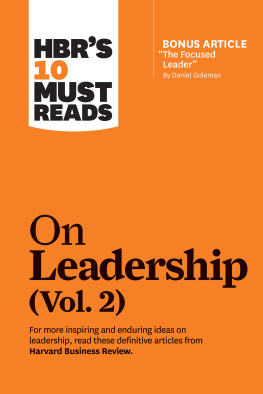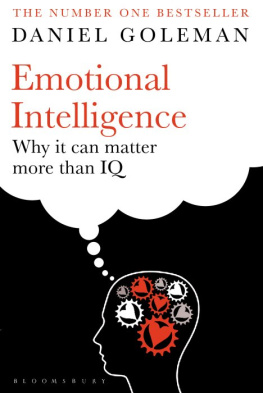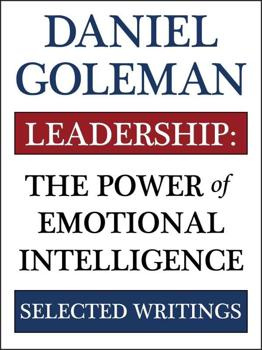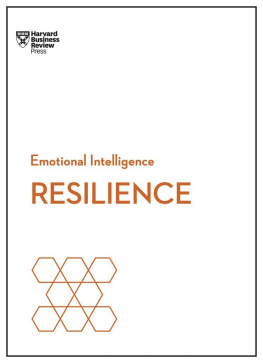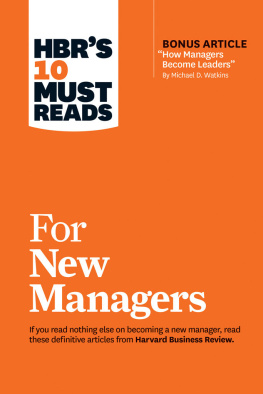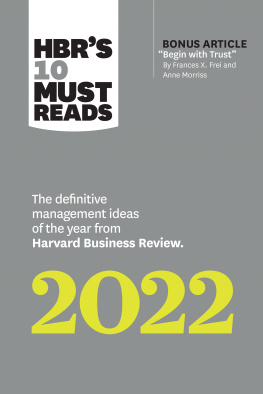HBRs 10 Must Reads series is the definitive collection of ideas and best practices for aspiring and experienced leaders alike. These books offer essential reading selected from the pages of Harvard Business Review on topics critical to the success of every manager.
Titles include:
HBRs 10 Must Reads 2015
HBRs 10 Must Reads 2016
HBRs 10 Must Reads 2017
HBRs 10 Must Reads 2018
HBRs 10 Must Reads 2019
HBRs 10 Must Reads 2020
HBRs 10 Must Reads for CEOs
HBRs 10 Must Reads for New Managers
HBRs 10 Must Reads on AI, Analytics, and the New Machine Age
HBRs 10 Must Reads on Boards
HBRs 10 Must Reads on Building a Great Culture
HBRs 10 Must Reads on Business Model Innovation
HBRs 10 Must Reads on Change Management
HBRs 10 Must Reads on Collaboration
HBRs 10 Must Reads on Communication
HBRs 10 Must Reads on Design Thinking
HBRs 10 Must Reads on Diversity
HBRs 10 Must Reads on Emotional Intelligence
HBRs 10 Must Reads on Entrepreneurship and Startups
HBRs 10 Must Reads on Innovation
HBRs 10 Must Reads on Leadership
HBRs 10 Must Reads on Leadership (Vol. 2)
HBRs 10 Must Reads on Leadership for Healthcare
HBRs 10 Must Reads on Leadership Lessons from Sports
HBRs 10 Must Reads on Making Smart Decisions
HBRs 10 Must Reads on Managing Across Cultures
HBRs 10 Must Reads on Managing in a Downturn
HBRs 10 Must Reads on Managing People
HBRs 10 Must Reads on Managing People (Vol. 2)
HBRs 10 Must Reads on Managing Risk
HBRs 10 Must Reads on Managing Yourself
HBRs 10 Must Reads on Mental Toughness
HBRs 10 Must Reads on Negotiation
HBRs 10 Must Reads on Nonprofits and the Social Sectors
HBRs 10 Must Reads on Public Speaking and Presenting
HBRs 10 Must Reads on Reinventing HR
HBRs 10 Must Reads on Sales
HBRs 10 Must Reads on Strategic Marketing
HBRs 10 Must Reads on Strategy
HBRs 10 Must Reads on Strategy (Vol. 2)
HBRs 10 Must Reads on Strategy for Healthcare
HBRs 10 Must Reads on Teams
HBRs 10 Must Reads on Women and Leadership
HBRs 10 Must Reads: The Essentials
Copyright
HBR Press Quantity Sales Discounts
Harvard Business Review Press titles are available at significant quantity discounts when purchased in bulk for client gifts, sales promotions, and premiums. Special editions, including books with corporate logos, customized covers, and letters from the company or CEO printed in the front matter, as well as excerpts of existing books, can also be created in large quantities for special needs.
For details and discount information for both print and ebook formats, contact .
Copyright 2020 Harvard Business School Publishing Corporation
All rights reserved
No part of this publication may be reproduced, stored in or introduced into a retrieval system, or transmitted, in any form, or by any means (electronic, mechanical, photocopying, recording, or otherwise), without the prior permission of the publisher. Requests for permission should be directed to , or mailed to Permissions, Harvard Business School Publishing, 60 Harvard Way, Boston, Massachusetts 02163.
First eBook Edition: Nov 2020
ISBN: 978-1-63369-910-6
eISBN: 978-1-63369-911-3
Leadership Is a Conversation
by Boris Groysberg and Michael Slind
THE COMMAND-AND-CONTROL APPROACH to management has in recent years become less and less viable. Globalization, new technologies, and changes in how companies create value and interact with customers have sharply reduced the efficacy of a purely directive, top-down model of leadership. What will take the place of that model? Part of the answer lies in how leaders manage communication within their organizationsthat is, how they handle the flow of information to, from, and among their employees. Traditional corporate communication must give way to a process that is more dynamic and more sophisticated. Most important, that process must be conversational.
We arrived at that conclusion while conducting a recent research project that focused on the state of organizational communication in the 21st century. Over more than two years we interviewed professional communicators as well as top leaders at a variety of organizationslarge and small, blue chip and start-up, for-profit and nonprofit, U.S. and international. To date we have spoken with nearly 150 people at more than 100 companies. Both implicitly and explicitly, participants in our research mentioned their efforts to have a conversation with their people or their ambition to advance the conversation within their companies. Building upon the insights and examples gleaned from this research, we have developed a model of leadership that we call organizational conversation.
Elements of organizational conversation

Idea in Brief
One-way, top-down communication between leaders and their employees is no longer useful or even realistic.
Todays leaders achieve far more engagement and credibility when they take part in genuine conversation with the people who work for and with them. A conversation is a frank exchange of ideas and information with an implicit or explicit agenda.
Corporate conversation reflects a new reality: Thanks in part to digital and social technologies, employees have found a public voice. Theyll use it whether their bosses like it or not.
The good news for leaders is that people can talk up a company in a way thats more interesting and attractive than any obvious public relations campaign.
Smart leaders today, we have found, engage with employees in a way that resembles an ordinary person-to-person conversation more than it does a series of commands from on high. Furthermore, they initiate practices and foster cultural norms that instill a conversational sensibility throughout their organizations. Chief among the benefits of this approach is that it allows a large or growing company to function like a small one. By talking with employees, rather than simply issuing orders, leaders can retain or recapture some of the qualitiesoperational flexibility, high levels of employee engagement, tight strategic alignmentthat enable start-ups to outperform better-established rivals.
In developing our model, we have identified four elements of organizational conversation that reflect the essential attributes of interpersonal conversation: intimacy, interactivity, inclusion, and intentionality. Leaders who power their organizations through conversation-based practices need not (so to speak) dot all four of these is. However, as weve discovered in our research, these elements tend to reinforce one another. In the end, they coalesce to form a single integrated process.
Intimacy: Getting Close
Personal conversation flourishes to the degree that the participants stay close to each other, figuratively as well as literally. Organizational conversation, similarly, requires leaders to minimize the distancesinstitutional, attitudinal, and sometimes spatialthat typically separate them from their employees. Where conversational intimacy prevails, those with decision-making authority seek and earn the trust (and hence the careful attention) of those who work under that authority. They do so by cultivating the art of listening to people at all levels of the organization and by learning to speak with employees directly and authentically. Physical proximity between leaders and employees isnt always feasible. Nor is it essential. What

